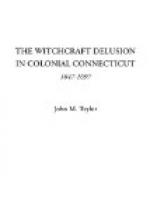HATHORNE:
“Dear sir, we have inquired;
Sifted the matter thoroughly
through and through,
And then resifted it.”
MATHER:
“If God permits
These evil spirits from the
unseen regions
To visit us with surprising
informations,
We must inquire what cause
there is for this,
But not receive the testimony
borne
By spectres as conclusive
proof of guilt
In the accused.”
HATHORNE:
“Upon such evidence
We do not rest our case.
The ways are many
In which the guilty do betray
themselves.”
MATHER:
“Be careful, carry the
knife with such exactness
That on one side no innocent
blood be shed
By too excessive zeal, and
on the other
No shelter given to any work
of darkness.”
New England Tragedies (4, 725), LONGFELLOW.
Whatever Mather’s caution to the court may have been, or his leadership in learning, or his ambition and his clerical zeal, there is thus far no evidence, in all his personal participation in the tragedies, that he lifted his hand to stay the storm of terrorism once begun, or cried halt to the magistrates in their relentless work. On the contrary, after six victims had been executed, August 4, 1692, in A Discourse on the Wonders of the Invisible World, Mather wrote this in deliberate, cool afterthought:
“They—the judges—have used as judges have heretofore done, the spectral evidences, to introduce their farther inquiries into the lives of the persons accused; and they have thereupon, by the wonderful Providence of God, been so strengthened with other evidences that some of the witch-gang have been fairly executed.”
And a year later, in the light of all his personal experience and investigation, Mather solemnly declared:
“If in the midst of the many dissatisfactions among us, the publication of these trials may promote such a pious thankfulness unto God for justice being so far executed among us, I shall rejoice that God is glorified.”
Wherever the responsibility at Salem may have rested, the truth is that in the general fear and panic there was potent in the minds, both of the clergy and the laity, the spirit of fanaticism and malevolence in some instances, such as misled the pastor of the First Church to point to the corpses of Giles Corey’s devoted and saintly wife and others swinging to and fro, and say “What a sad thing it is to see eight firebrands of hell hanging there.”
This conspectus of witchcraft, old and new, of its development from the sorcery and magic of the ancients into the mediaeval theological dogma of the power of Satan, of its gradual ripening into an epidemic demonopathy, of its slow growth in the American colonies, of its volcanic outburst in the close of the seventeenth century, is relevant and appropriate to this account of the delusion in Connecticut, its rise and suppression, its firm hold on the minds and consciences of the colonial leaders for threescore years after the settlement of the towns, a chapter in Connecticut history written in the presence of the actual facts now made known and available, and with a purpose of historic accuracy.




